This gluten-free challah bread has a soft and fluffy texture, braided beautifully and then topped with sesame seeds and poppy seeds for a distinctive taste. With some simple ingredients and a bit of hands-on time, you can share this bread on Shabbat or Rosh Hashanah or any time of the year.
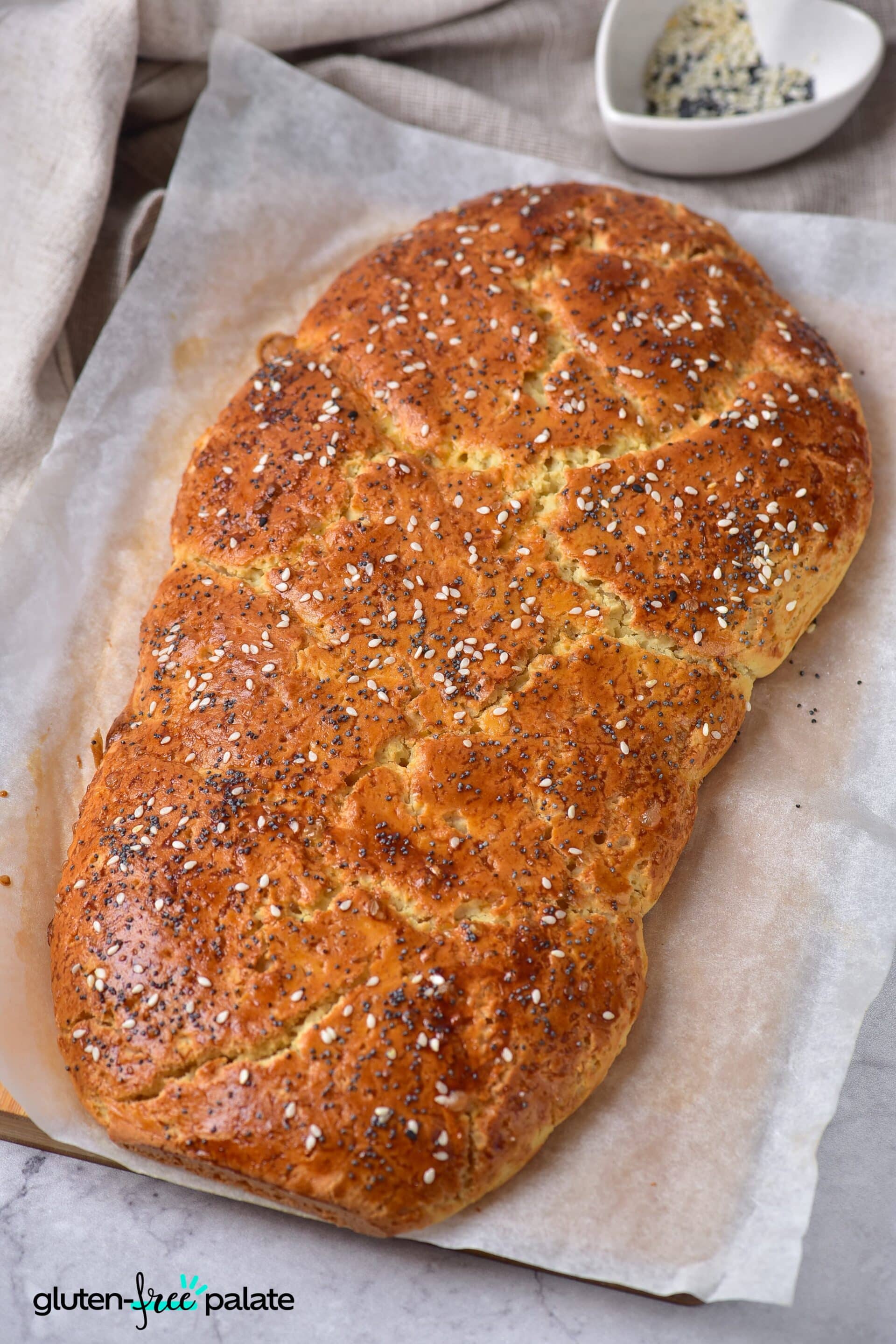
What is challah, and when is it common to eat it? Challah is commonly eaten on Jewish holidays like Rosh Hashanah, Yom Kippur, and Shabbat. As well as on festive occasions such as weddings and bar/bat mitzvahs. The challah symbolizes unity, and it is customary to share this bread with friends and family. Most families have their special recipes and techniques for making challah.
Looking for the perfect gluten-free bread recipe? If you're in the mood for something sweet, try this easy gluten-free lemon bread, which is both tangy and sweet at the same time. For those who love the tangy taste of sourdough bread, try this gluten-free sourdough bread recipe. If you're short on time or simply prefer the convenience of a bread maker, check out the list of the best gluten-free bread makers for an easy way to make fresh, homemade bread whenever you want it.
Do you want to learn how to create mouth-watering artisan loaves of bread that are entirely gluten-free? Then the Deliciously Gluten-Free Artisan bread course on Udemy is for you!
Having a busy weeknight? Get $30 off your first Purple Carrot box using the promo code CARROT30. A Purple Carrot box is a meal delivery service that provides plant-based, vegan meal kits with pre-portioned ingredients and step-by-step instructions to make cooking healthy and delicious meals easier. Try it now!
Gluten-Free Challah Recipe
This gluten-free challah is a wonderful bread recipe that is perfect for anyone looking for a delicious and visually stunning gluten-free bread recipe. The best thing about this bread is its soft and fluffy texture. This texture is achieved by combining gluten-free flour and quick dry yeast, which works together to create a light and airy dough.
The taste of this bread is also so good. The combination of sugar, eggs, and butter gives this bread a subtle sweetness balanced by the nutty flavors of the sesame and poppy seed toppings. It is a versatile bread that is perfect for any meal. Enjoy it plain, or used it to make French toast or bread pudding.
It is also easy to make, despite its intricate braided appearance. With just a few simple ingredients, patience, and practice, you can create a beautiful and delicious loaf of challah to impress your friends and family. It's perfect for sharing, whether you are celebrating a Jewish holiday or simply enjoying a meal with loved ones.
Related: Gluten-Free Matzo Ball Soup
Why You’re Going to Love This Gluten-Free Challah
Perfect for sharing - This gluten-free challah is perfect for sharing on traditional Jewish occasions so you can be part of the festivities.
Easy to make and tastes so good - Don't let the braiding of the bread put you off making this delicious bread. It is so easy to make, and once you taste it, you will make it more often.
Soft and fluffy texture - This bread has a lovely soft and fluffy texture combined with the sweet flavor from the sugar, eggs and butter and then offset with the crunch and a hint of nuttiness from the sesame and poppy seeds, making it just so good!
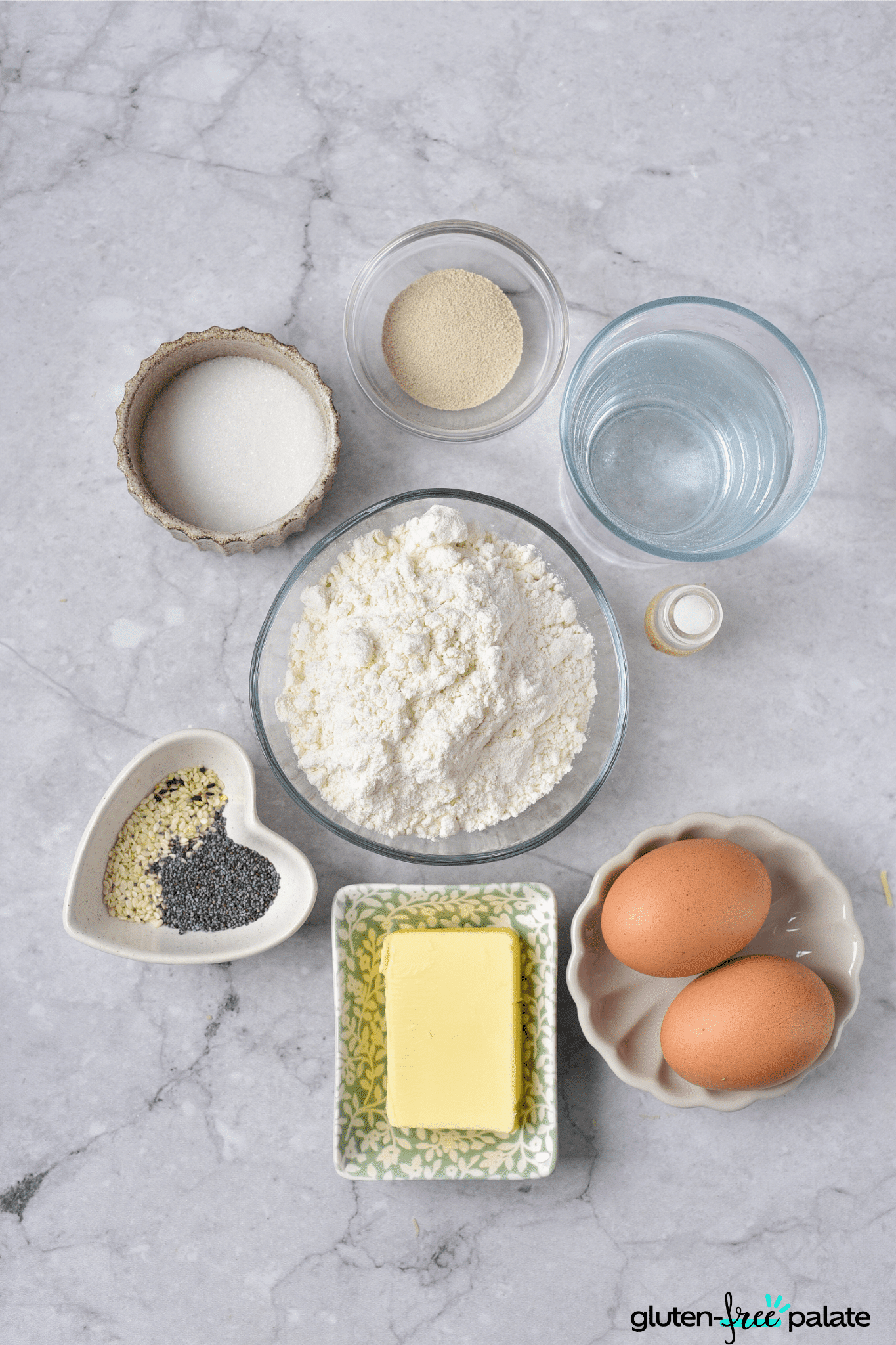
Ingredients in Gluten-Free Challah
Yeast - 2 tsp dry quick yeast. The yeast is the key to the light and fluffy texture.
Butter - 3 tbsp unsalted butter. We add salt, so buy unsalted butter.
Water - 1 cup warm water.
Sugar - 4 tbsp sugar.
Salt - ⅕ tsp salt. I like to add salt to control the amount of salt.
Eggs - 2 eggs at room temperature. This ingredient creates a soft and tender crumb.
Flour - 2 ½ cups regular gluten-free flour.
Sesame - 1 tbsp sesame seeds.
Poppy seeds - 1 tbsp poppy seeds.
Equipment Needed for This Gluten-Free Challah
Mixing bowls - These Pyrex mixing bowls are useful for proofing the yeast and also mixing the ingredients.
Plastic wrap - I like this plastic wrap with a built-in cutter. This will be used to cover the dough while it proofs.
Parchment paper - This parchment paper is used to bake the bread, so it is a good idea to let it rise on it too.
Pastry brush - This pastry brush is useful for adding egg yolk to the dough before baking.
Baking sheets - Use a non-stick baking sheet that is big enough for the bread to proof on.
If you have any questions about making Gluten-Free Challah, please leave a comment, and we will get back to you as soon as possible.
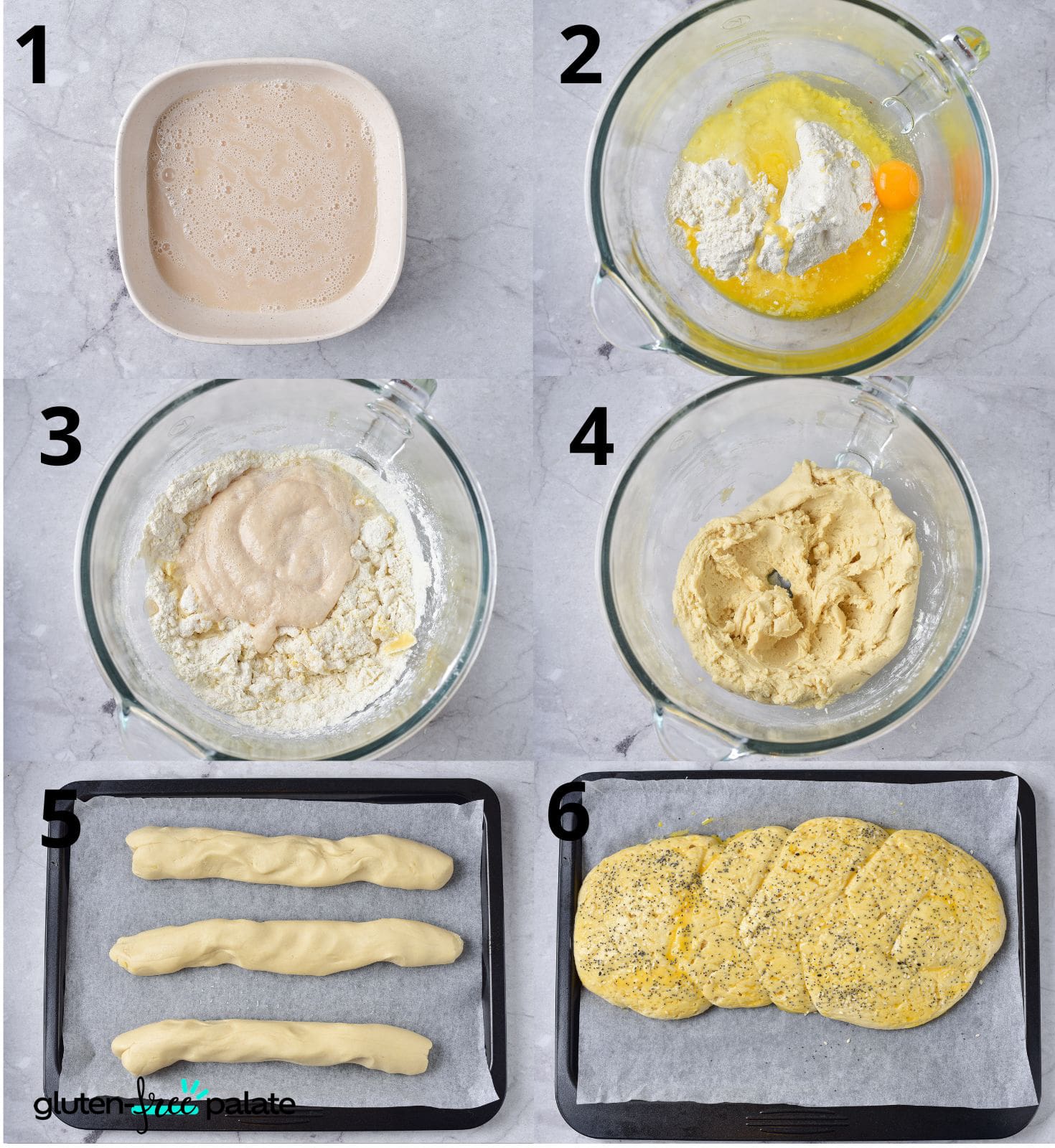
How to Make Gluten-Free Challah
- Mix water (about 100F), sugar, water, and yeast in a bowl. Cover the bowl with plastic wrap and leave it in a warm place for 10 minutes until foam appears on the water's surface.
- Mix flour, melted butter, salt, whole egg, and egg white in a bowl. Leave the yolk to brush the challah.
- Pour the yeast, which has already reacted with sugar, into the bowl.
- Mix the ingredients while adding flour to make a soft and not very sticky dough.
- Since gluten-free flour is used here, the challah formation sequence will differ. Since there will be only one rise of the dough. Therefore, immediately after kneading, divide the dough into three equal parts and form bundles.
- Form a braid from the bundles. It is better to do this immediately on parchment, which is done on the baking sheet. Cover the baking sheet with cling film and put it in a warm place for 30-50 minutes. Also, preheat the oven to 350F.
- When the challah rises, brush it with yolk, and sprinkle it with sesame and poppy seeds. Place in a hot oven and bake for 25-30 minutes.
- After the gluten-free challah is baked, let it cool for half an hour or an hour, then cut it into pieces and enjoy!
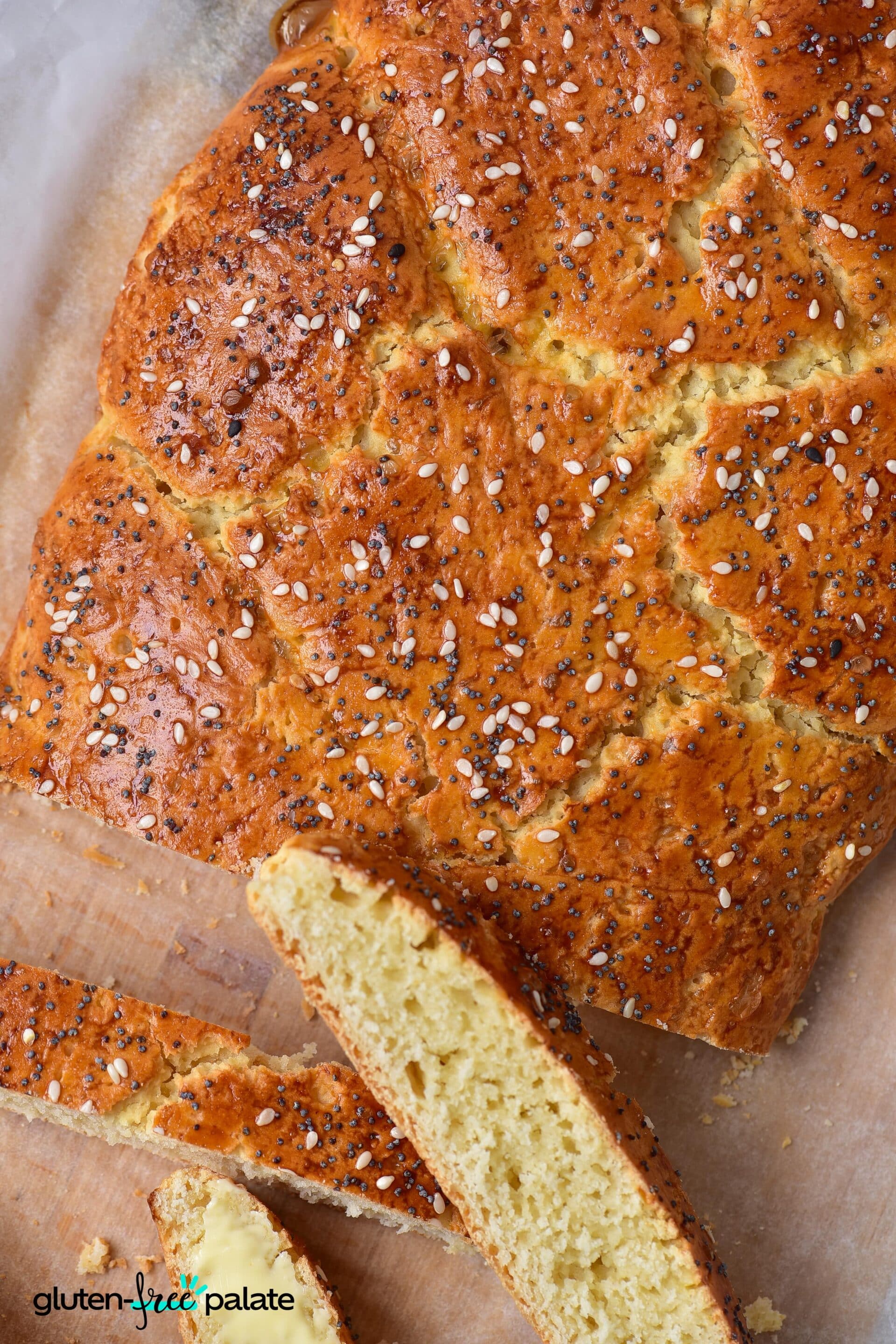
Tips for Making the Best Gluten-Free Challah
Use the recommended flour - Regarding gluten-free baking, not all gluten-free flours are created equally.
Ensure ingredients are at room temperature - It always makes a recipe turn out as it should if the ingredients are all at room temperature.
Don't overmix - Overmixing the dough will result in dense and heavy bread, which is not what you want for this bread.
Let the dough rise enough - It is important to let the dough rise correctly.
Braid the dough slowly - Gluten-free dough is more delicate, so a loose braid will work perfectly.
Use the egg yolk - Use the egg yolk as an egg brush before baking it. This will result in a nice golden brown bread crust.
Frequently Asked Questions
How Do I Store Gluten-Free Challah?
Store your bread wrapped in a plastic container. It can be stored at room temperature for 2-3 days.
Can I Freeze Gluten-Free Challah?
Wrap it in plastic wrap and then in a freezer-safe container. It keeps well for 2-3 months.
Can You Make This Gluten-Free Challah Ahead of Time?
You can make the bread up to the step where it is braided and store it overnight and bake it the next day. Alternatively, bake it and then store it at room temperature for 2-3 days. If required for a later period, then freeze it.
What Substitutions / Replacements Can I Make in This Gluten-Free Challah?
Egg-free - Try an egg replacer. I have not as yet.
Vegan - You would need to try vegan alternatives for the eggs and butter.
Sesame seeds and poppy seeds - You can also use pumpkin seeds or sunflower seeds. You can also leave it off.
Why Is Challah Dipped In Salt Before It Is Eaten?
Challah is dipped in salt as part of the Jewish tradition representing the salt used in Temple offerings in ancient times. Salt also represents the covenant between God and the Jewish people.
What Makes Challah Bread Different?
There are 3 things that make this bread different, namely the texture, taste, and shape. The texture is soft and fluffy. The bread has a slightly sweet taste offset by the seeds. The braiding of the bread gives it a distinct difference from traditional loaves of bread.
Is Challah Bread Gluten-Free?
Traditionally challah bread was made with gluten-containing flour. But with this recipe, you can enjoy gluten-free challah by using gluten-free ingredients.
What Are Good Toppings For Challah?
- Cinnamon Sugar - Mix together some cinnamon and sugar and sprinkle it on top of the bread before baking for a sweet and spicy flavor.
- Everything Bagel Topping - Mix together poppy seeds, sesame seeds, dried garlic, dried onion, and salt, and sprinkle it on top of the bread for a savory and flavorful topping.
- Honey - Brush the bread with honey before baking to add a sweet and sticky glaze.
- Chocolate Chips - Mix some chocolate chips into the dough before baking for a decadent sweet treat.
How Do You Serve Gluten-Free Challah Bread?
Gluten-free braided bread can be served in various ways.
- Toasted - Toast slices of the bread and serve with butter, jam, or honey for a quick and easy breakfast or snack.
- French Toast - Use slices of gluten-free challah to make French toast, dipping them in egg and milk mixture and cooking them in a pan until golden brown.
- Sandwiches - Use the bread to make sandwiches, filling them with your favorite meats, cheeses, and veggies.
- Bread Pudding - Use the bread to make a delicious gluten-free bread pudding, adding eggs, milk, sugar, and your favorite toppings.
- Bread Crumbs - Use the bread to make gluten-free bread crumbs for breading chicken, fish, or vegetables.
How Do You Braid Gluten-Free Challah Bread Strands Into A Loaf?
- Divide the dough into 3 equal portions. Three or four strands are common for challah bread. I have used 3.
- Roll each portion of dough into a long, thin strand, using a bit of gluten-free flour to prevent sticking.
- Place the three strands parallel to each other and pinch the top ends together.
- Take the right strand and cross it over the middle strand, then take the left strand and cross it over the new middle strand.
- Repeat this process, alternating right and left strands until the entire loaf is braided.
- Pinch the bottom ends of the strands together and tuck them under the loaf.
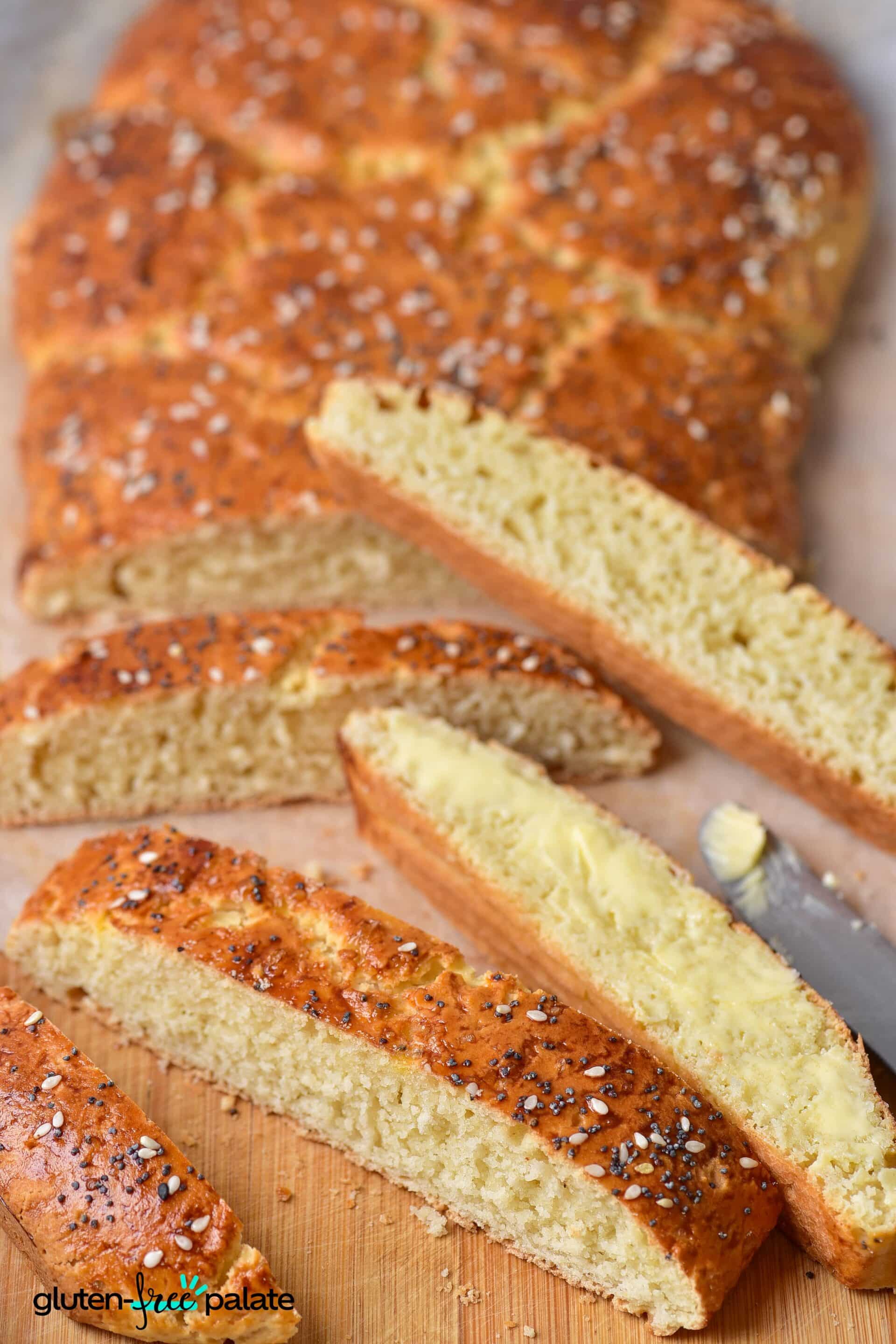
Gluten-Free Challah
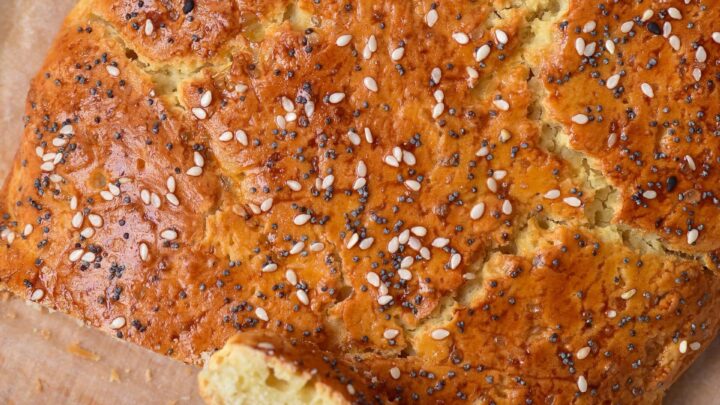
Make this traditional Jewish challah bread with this gluten-free challah recipe. It has a soft and fluffy texture, is braided beautifully, and has a great taste.
Ingredients
- 2 tsp dry quick yeast
- 3 tbsp unsalted butter
- 1 cup warm water
- 4 tbsp sugar
- ⅕ tsp salt
- 2 eggs
- 2 ½ cups regular gluten-free flour
- 1 tbsp sesame
- 1 tbsp poppy seeds
Instructions
- Mix water (about 100F), sugar, water, and yeast in a bowl. Cover the bowl with plastic wrap and leave it in a warm place for 10 minutes until foam appears on the water's surface.
- Mix flour, melted butter, salt, whole egg, and egg white in a bowl. Leave the yolk to brush the challah.
- Pour the yeast, which has already reacted with sugar, into the bowl.
- Mix the ingredients while adding flour to make a soft and not very sticky dough.
- Since gluten-free flour is used here, the challah formation sequence will differ. Since there will be only one rise of the dough. Therefore, immediately after kneading, divide the dough into three equal parts and form bundles.
- Form a braid from the bundles. It is better to do this immediately on parchment, which is placed on a baking sheet. Cover the baking sheet with cling film and put it in a warm place for 30-50 minutes. Also, preheat the oven to 350F.
- When the challah rises, brush it with yolk, and sprinkle it with sesame and poppy seeds. Place in a hot oven and bake for 25-30 minutes.
- After the challah is baked, let it cool for half an hour or an hour, then cut it into pieces and enjoy!
Notes
- This recipe only requires one rise.
Recommended Products
As an Amazon Associate and member of other affiliate programs, I earn from qualifying purchases. They never cost you extra.
-
Bob's Red Mill Resealable Gluten Free All Purpose Baking Flour, 22 Ounce (Pack of 2)
-
Pyrex Smart Essentials 3-Piece Prepware Mixing Bowl Set, 1-Qt, 1.5-Qt ,and 2.5-Qt Glass Mixing Bowls, Dishwasher, Microwave and Freezer Safe
-
Reynolds Kitchens Quick Cut Plastic Wrap, 225 Square Feet
-
Reynolds Kitchens Parchment Paper Roll, 60 Square Feet
-
Pastry Brush Natural Bristle Wooden, MSART Basting/Food Brush, with Beech Wood Handle and Rope Hook, Great for Butter, Cookies, Oil, Bread, Frosting. Easy to Clean (1 inch)
-
NutriChef Non-Stick Kitchen Oven Baking Pans-Deluxe & Stylish Nonstick Gray Coating Inside & Outside, Commercial Grade Restaurant Quality Metal Bakeware with Red Silicone Handles NCSBS3S, 3 Piece Set
Nutrition Information:
Yield:
8Serving Size:
1Amount Per Serving: Calories: 89Total Fat: 6gSaturated Fat: 3gTrans Fat: 0gUnsaturated Fat: 3gCholesterol: 58mgSodium: 79mgCarbohydrates: 7gFiber: 0gSugar: 6gProtein: 2g
This nutrition info is based on the exact ingredients and brands used at the time. It may not be 100% accurate. Please check your ingredients nutrition labels.








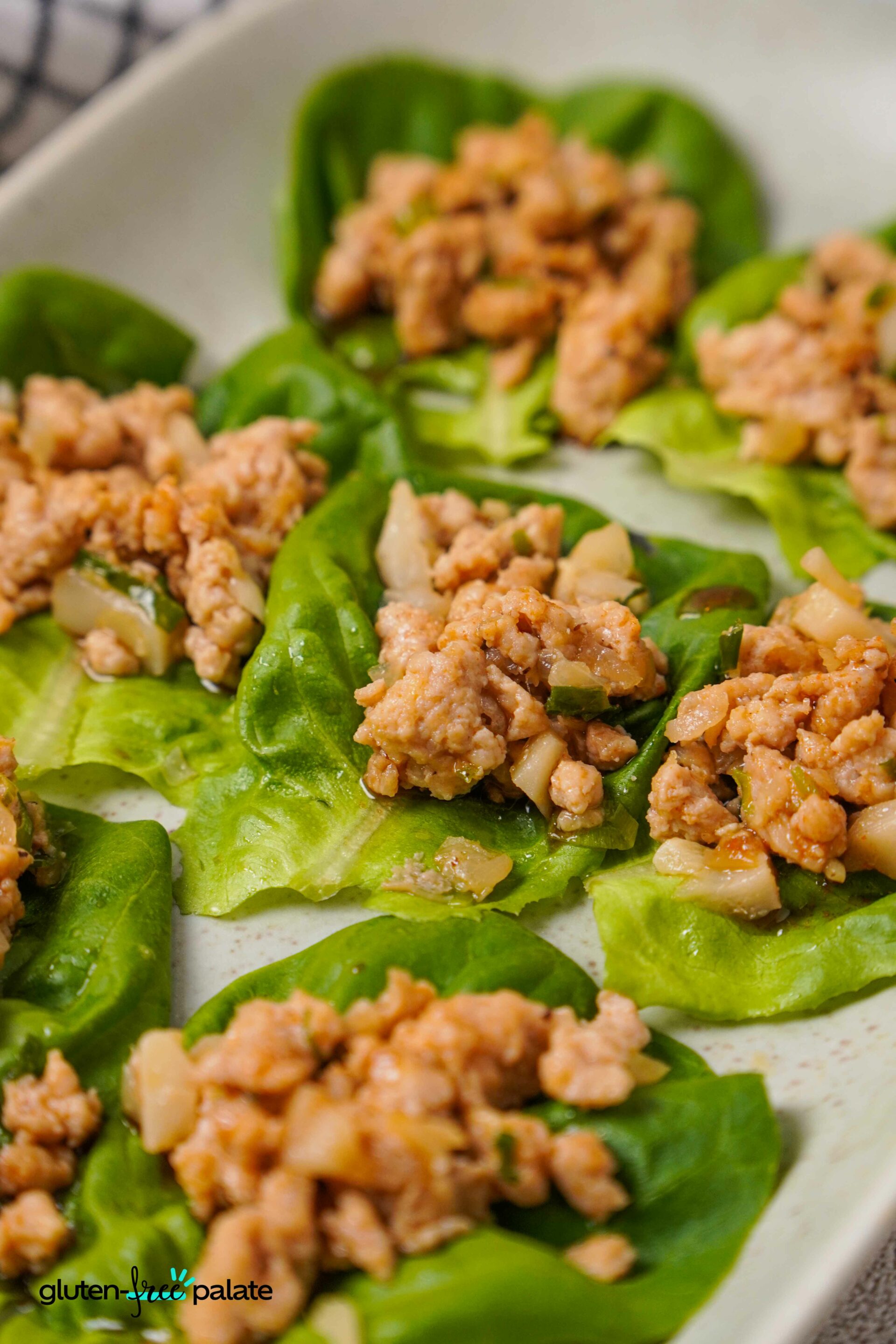
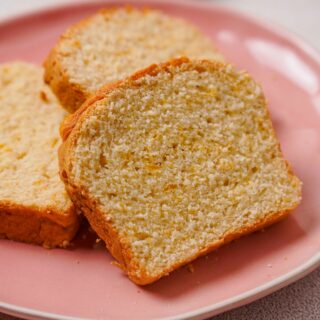
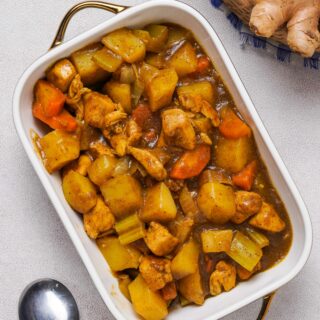
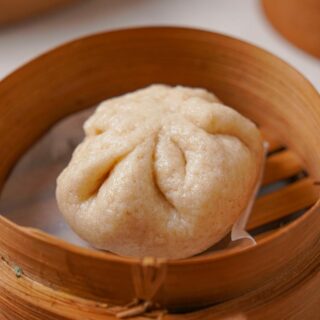
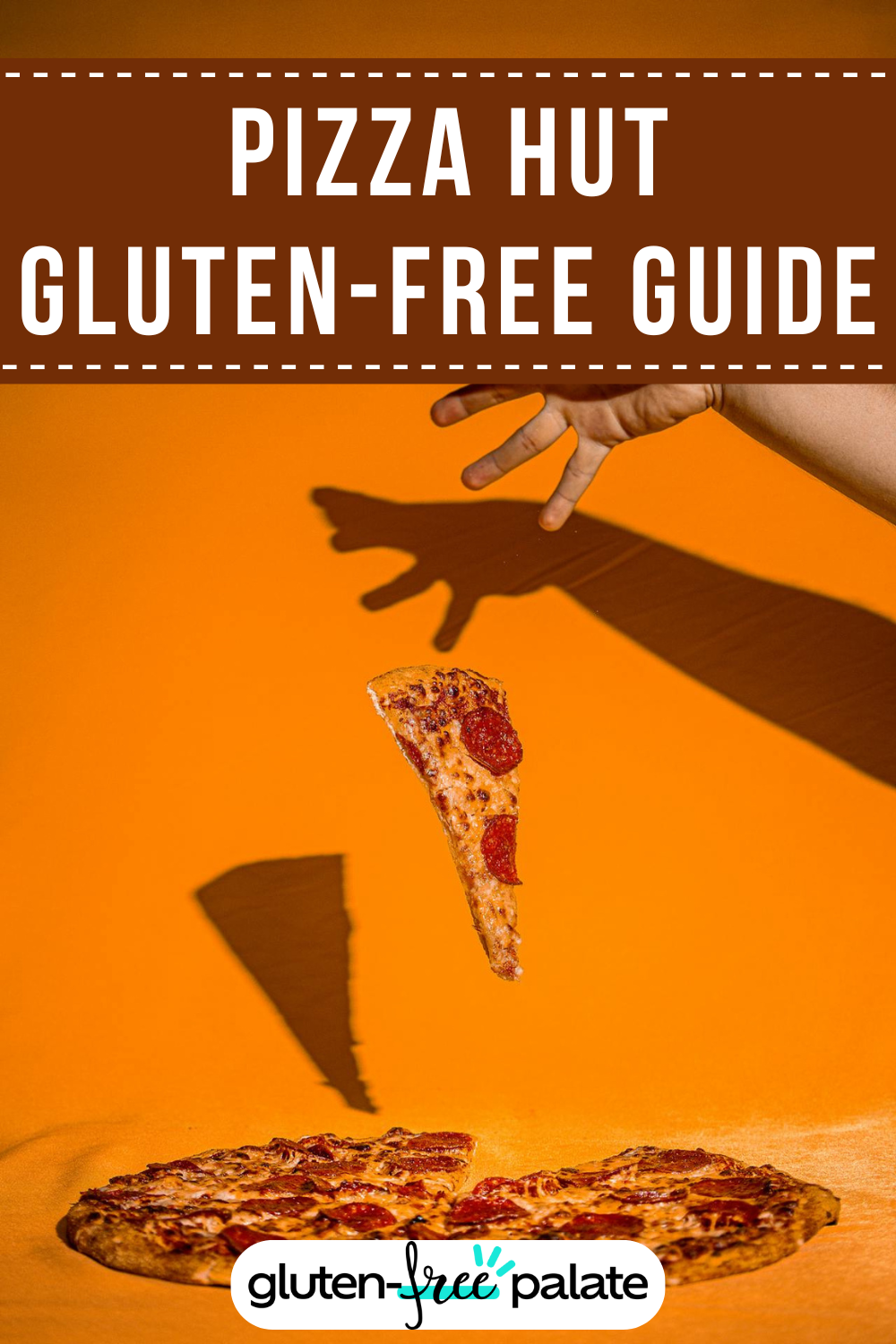
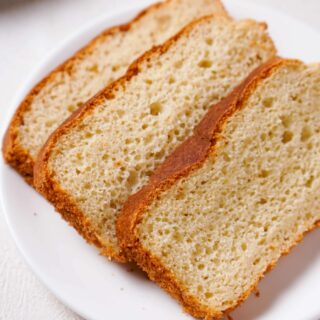
silvana f wood
Thank you for the recipe, I will only make it again when our granddaughter visits, as she is celiac I found it too hard to shape, I hope at least it will taste OK after baking!
Wendy Stoltz
You're welcome Silvana for the recipe! I understand that working with gluten-free dough can be a bit challenging, especially when it comes to shaping. Don't worry too much about the appearance; the taste is what matters most.
Suzanne
Hi, thanks for the recipe. I can't make sense (a picture in my head!) of what it means when you say the parchment/braid should be covered with a baking sheet which is then covered in cling film - what is covering what please!
"Form a braid from the bundles. It is better to do this immediately on parchment, which is covered with a baking sheet. Cover the baking sheet with cling film and put it in a warm place for 30-50 minutes. Also, preheat the oven to 350F."
Wendy
Hi Suzanne,
Here's a clarification:
Place the parchment paper on top of the baking sheet. This is done to provide support and prevent the dough from sticking to the surface or becoming misshaped.
Cling Film (Plastic Wrap): Cover the baking sheet, along with the braid, with cling film (plastic wrap). The cling film helps to keep the braid from drying out while it rests and rises.
Thanks
MaryJo Walker
Hi, I'm gluten sensitive. Can I use your recipe in my toast master
bread maker?I live above6,500 in altitude; do I need to make adjustments to the recipe due to the altitude?
I tried the challa recipe that came with the toast master bread maker but
it turned out like rocks. I can't obtain gf kosher challa in my area; so I use
gf matza crackers instead. I sure miss eating challa! Thanks for helping
me. MaryJo
Wendy Stoltz
Hello MaryJo,
Thank you for reaching out. I have not made it in a bread maker so I am not sure if it will work as it might not yield the exact same texture and appearance as when made traditionally.But give it a try and let us know. As for your high altitude living situation, it's crucial to make adjustments to the recipe to accommodate the changes in atmospheric pressure and temperature. Here are some tips to help you with the adjustments for baking at high altitude:
Yeast - Increase the amount of yeast by about 25% to allow the bread to rise properly.
Liquid - You may need to slightly reduce the amount of liquid used in the recipe, as the higher altitude can cause increased evaporation and affect the consistency of the dough. However, gluten-free flours tend to absorb more liquid, so you might not need to make significant adjustments.
Temperature - Consider increasing the baking temperature slightly (usually by 15-25°F) and reducing the baking time. Keep a close eye on the bread during baking to prevent over-drying or burning.
When making these adjustments, it's important to experiment a bit to find the right balance for your specific altitude and climate conditions.
I hope these tips help you achieve better results with your gluten-free challah bread
Jodi Sweet
Am I reading this correctly that no xanthan gum is used? I want to be sure before I try making it! Thanks!
Wendy
Hi Jodi,
Yes, that is correct.